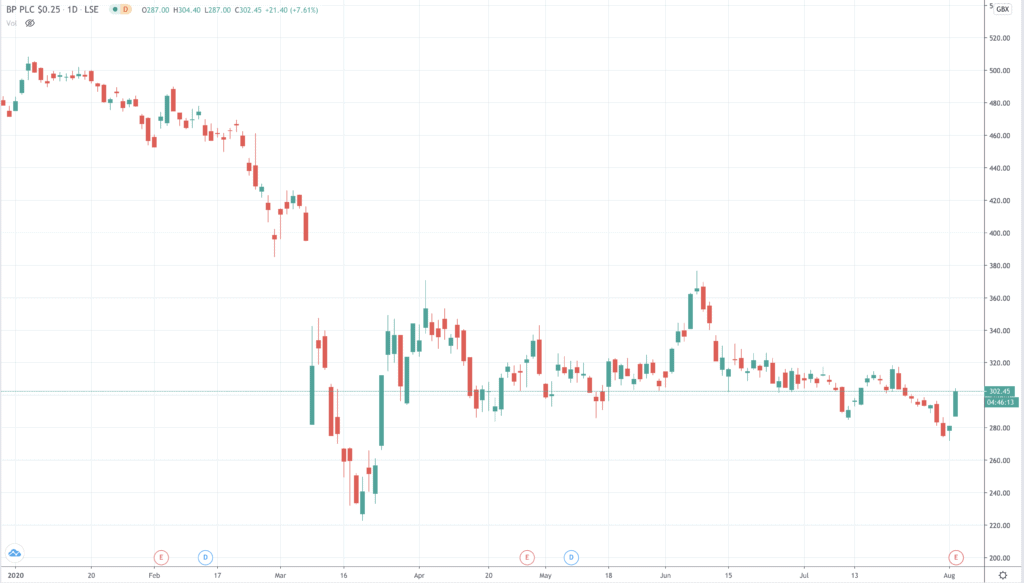
BP second-quarter results are in and they are not pretty, with the UK-based oil company cutting its dividend in half to $5.25 a share.
That’s bad news for income investors – for whom BP is a favourite because of its hitherto generous quarterly cash payouts, but the dividend cut was already priced in, with the shares leaping in value.
The shares climbed as much as 8% to 302p in London trading partly, then, because the company will no longer be borrowing from Peter to pay Paul, as seen in its spiralling debt position and cost-cutting and capital retrenchment to protect the dividend payouts. Future profits were increasingly seen as threatened by the ring-fencing of dividend payouts at all costs.
In short, an unsustainable progressive dividend policy has come to an end, and so too perhaps the age of Big Oil and its ever-expanding drilling capacity. On that, BP expects daily refining throughput to fall from 1.7 million barrels a day to 1.2 million over the next 10 years and exploration capital expenditure to be halved.

Dividend cover improved at a stroke
BP’s dividend cover – how much of the dividend can be paid out of company earnings – is 1.3. A ratio below 1.5 is considered unhealthy and 2.0 healthy. By cutting the dividend, BP has brought immediate improvement in that quarter.
At the beginning of the year distribution of profits to shareholders was actually increased, with the dividend raised to $10.50, up 2.4% year on year. However, the optimism informing that decision has been sunk by the Covid Pandemic demand shock. Nevertheless, BP says it is still committed to returning 60% of surplus cash to shareholders through buybacks.
The oil major has swung to a loss of $16.8 billion compared to a profit of $1.8 billion in the second quarter of 2019. The record loss included a $10.9 billion charge and 1.7 billion in exploration cost write-offs
Underlying replacement cost (RC) profit turned into a heavy loss of $6.7 billion. This compares with a RC profit of $2.8 billion in Q2 2019. The loss came in better than expected, which also helped the share price this morning.
Trading strength offsets some of the Covid losses
In common with other majors, BP’s trading business delivered a “strong result”. The volatility in the oil price which at one stage saw crude oil futures print a negative price for the first time in history, provided ample room for trading profits. Brent crude oil benchmark is currently priced at $43.45, 1.59% lower (West Texas Intermediate $40.36).
Replacement cost profit is a non-GAAP measure that accounts for inventory gains and losses on the balance sheet as opposed to the income statement. The figure is closely watched by analysts because it takes into account the shifts in the oil price, ongoing exploration-write offs and how such factors impact company inventory.
BP is cutting its dividend for the first time since the Deepwater Horizon oil spillage disaster in the Gulf of Mexico in 2010, the costs of which are still showing up on its books.
As of June 2018 the disaster had cost BP $65 billion.
Energy companies make up 10% of the FTSE by sectoral weighting, which means many pension funds and retail investors invested in FTSE 100 tracker funds will hold BP.
The company’s shares as at 31 July yielded 11.34%, which placed it among the best payers on the UK senior market. Its yield compares to an average for the FTSE 100 of 4.81%.
BP going beyond petroleum
Chief Executive Officer Bernard Looney, who replaced Bob Dudley at the beginning of the year, took the opportunity to flesh out plans to increase investment in clean energy and reduce the company’s carbon emissions, for which it has earmarked a capital spend of $5 billion per annum, representing a 10-fold increase – still substantially less than the up to $16 billion outlay for oil and gas exploration and development.
“These headline results have been driven by another very challenging quarter, but also by the deliberate steps we have taken as we continue to reimagine energy and reinvent bp. In particular, our reset of long-term price assumptions and the related impairment and exploration write-off charges had a major impact. Beneath these, however, our performance remained resilient, with good cash flow and – most importantly – safe and reliable operations,” said Looney in a statement accompanying the results.
BP will aim to reduce hydrocarbon production 40% by 2030. Other measures include the build-out of 70,000 electricity-charging points (currently 7,500), while renewable energy capacity will jump to 50 gigawatts (5Gw last year).
BP looks strong against the competition – net debt reduced by $10 billion
Today’s results suggest it would be foolish to write-off BP as a ‘legacy’ stuck in the past.
Looney’s strategy signposts a viable road forward. It has begun to address the systemic threat of climate change to company profits, reducing costs and most importantly debt.
Net debt stands at $40.9 billion, but that is an impressive $10 billion reduction on the $51.4 recorded in the first quarter of this year. Net debt for the first half also compares favourably with 2019 ($40.9 billion v 46.5 billion).
BP is accelerating its shift to low-carbon. Whether it is fast enough is determined by climate change and the performance of its oil major peers.
On this showing, BP is headed in the right direction and ahead of the game, at least as far as its American competitors are concerned, if not fast enough for those who see the threat of damaging and irreversible climate change as requiring more radical societal-wide attention.
With the share price down 40% before today’s action and the dividend cut evidently already priced in, there is still room to buy.

Question & Answers (0)